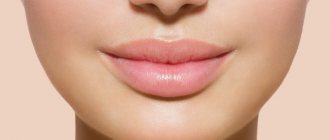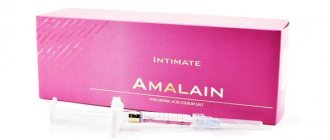The whole truth about side effects after contouring
Injection methods of rejuvenation are gaining more and more popularity every year. Innovative lines of fillers are being produced, new procedures are being introduced, which increases the effectiveness of contouring. Of course, side effects are possible. However, they happen extremely rarely or are temporary.
However, most cosmetology centers are silent about unpleasant consequences. Such situations frighten clients, because they were not warned and are afraid of any unwanted manifestations.
Let's look at the possible side effects of contouring and find out the whole truth about them:
- What should women be prepared for after the session?
- Is it possible to prevent their occurrence?
- What to do if they arise?
Side effects of contouring
According to statistics, unpleasant consequences from rejuvenation procedures are recorded in less than 5% of cases. The likelihood of their occurrence, although small, is still there and you need to be prepared for it.
List of possible side effects after contouring :
- Strong pain. Fillers are injected. Piercing the skin with a needle is an unpleasant process, especially in delicate areas - the lips. Advanced modern drugs include the local anesthetic lidocaine. Pain sensations are reduced by 50% or more, but in some women sensitivity is increased and such manipulations are accompanied by discomfort.
- Hematomas (bruises). All facial tissues are penetrated by small capillaries and nerve endings. When the needle is inserted, they are touched and injured. This is where bruises occur. They dissolve on their own.
- Edema . This is a normal reaction of the body to the injection of filler under the skin. The drug attracts fluid from neighboring tissues. After a few days, the swelling subsides and only the desired volume remains, for which the cocktail was introduced.
- Inflammation . Occurs when sanitary standards are not observed. In modern aesthetic medicine, such cases are very rare. However, if you turn to an incompetent doctor or even go to do the procedure at home, then the risks of inflammation increase several times.
- Allergic reaction. This is an inadequate immune response to the injected filler in case of individual intolerance to the drug. This point is completely dependent on the characteristics of the body.
- Consolidation or migration of filler . The gel may bulge, forming globules, bumps, and lumps. This situation is typical when the filler is injected very superficially or too deeply. This is often a mistake made by an inexperienced cosmetologist. This may also be due to the anatomical features of the face: in mature women, voids form under the skin with age. This is where the filler migrates. Movement of the gel is noted when rubbing or massaging the injection site in the first few days after the session.
- Vascular trauma or embolism. No specialist is immune from this. Similar problems are typical for areas with abundant blood supply - the nasolabial triangle. We are not talking about capillaries, but about larger units - arteries and veins. If you inject too much filler near a vessel, the gel will crush it. The passage of blood becomes difficult and tissue ischemia (oxygen starvation) occurs. If the drug gets directly into the lumen of the vessel, it becomes clogged. In the absence of medical accommodation, necrosis may develop.
Help and prevention for side effects after contouring
Severe pain can be suppressed using fillers that contain lidocaine. It is not recommended to touch the puncture site and try to somehow “stretch” the gel. This will only increase tissue trauma and increase discomfort. If the pain is excessively intense, you should consult a doctor. Perhaps this is an individual feature - high sensitivity and it will be enough to take a painkiller, or maybe this is a more serious complication.
Hematomas and swelling go away on their own if you follow all the doctor’s recommendations for skin care after contouring. These side effects cannot be prevented. The cosmetologist will advise you on the necessary creams or ointments, and will also advise you on the rules of the recovery period.
Inflammatory processes at injection sites begin when sterility is violated during the procedure. A professional will not make such mistakes, which once again proves the prestige of cosmetology centers. It is not recommended to contact doctors at home or even turn to “self-taught” doctors. If inflammation occurs in the area of the needle puncture, you should immediately consult a doctor. The solution often requires surgery.
No one is protected from allergies Hyaluronic acid is a substance produced by the human body, so its rejection is impossible. But the anesthetic lidocaine, which is part of the fillers, can activate the immune system and cause an inadequate reaction. Before performing contour plastic surgery, the specialist carefully interviews the client and finds out the possibility of allergies. If the reaction has already begun, the doctor will provide the necessary assistance and advise on further tactics.
Compaction and migration of filler can only be eliminated with an additional session. The drug hyaluronidase is injected. Roughly speaking, this is a “cancellation” procedure. The substance destroys and removes previously incorrectly administered hyaluronic acid from the body. If we are talking about a filler on a different basis (collagen, Radiesse), then you will need to wait several months until it resolves on its own. To avoid a similar negative experience, you must carefully search for a professional cosmetologist.
If a large vessel was damaged during contouring , the specialist will provide you with the necessary assistance and advise on further care of the intervention area. If you experience sharp pain, intense redness, a burning sensation or other discomfort, you should contact your cosmetologist. Perhaps this is just excessive sensitivity or a hematoma, or maybe a sign of tissue ischemia when the vessel is compressed. You should not wait and be patient, because this can lead to necrosis or infection of the puncture site. Damage or compression of the vessel cannot be prevented.
General concept of fibrous formation
Despite the fact that fillers based on hyaluronic acid are completely compatible with the human body in terms of biological characteristics, nevertheless, after administration of the drug, inflammation may develop, which usually goes away after 2-3 days.
If the formations persist for two weeks or more, you should consult a doctor - probably the inflammatory process has become chronic and the growth of connective tissue begins to be excessive. Such local compaction (the medical term is fibrosis) in the area where the special gel was introduced indicates the beginning of the process of producing new collagen fibers. Capsules of the fibrous type become noticeable not only upon palpation, but also visually (the relief of the skin changes).
Fibrous tissue deformation is considered a late and difficult-to-treat consequence of correction and modeling of facial contours with fillers.
Possible causes
Multiple growing fibrous capsules, lumps and other compactions are the most common complications after filler injection. Of course, only a doctor can determine the cause of their appearance, while in some cases the cause of fibrosis is never established and is considered an individual reaction of the body, but some factors can be listed :
- direct transfer of funds or its low quality;
- incorrectly chosen injection technique;
- development of a focus of inflammation;
- mechanical damage to the walls of blood vessels;
- individual reaction of rejection of a foreign substance by the body;
- in the injection area there is a noticeable growth of connective tissue - scars, nodules or cysts (for example, hyaluronic acid enhances the production of fibroblasts);
- failure to comply with hygiene and care rules, and as a result, infection;
- unprofessionalism of the cosmetologist.
In addition, the formation of fibrous capsules can be provoked by an incorrectly calculated dose of the drug, as well as its too superficial administration.
Consequences and measures to prevent the situation from getting worse
The appearance of fibrous nodes after the filler injection procedure is not a fatal condition. Fibrosis is usually perceived as a kind of cosmetic defect of the skin. However, mechanical damage to such a seal may result in complications:
- minor bleeding;
- wound infection;
- pain syndrome;
- necrosis of injured tissues.
The last of the listed complications - tissue necrosis - is worth considering in more detail, due to the fact that it is the most undesirable, unpleasant of all possible consequences of the injection of fillers. In addition, the result of such a complication can even be fatal.
Characteristic signs and symptoms of fibrosis
The introduction of fillers is accompanied by a variety of complications, many of them are very similar to each other: swelling, nodules, bumps, keloids, scars, granulomas. Therefore, it is necessary to be able to distinguish fibrous type capsules from other neoplasms.
Symptoms indicating the development of fibrosis:
- Neoplasms on the face are hard when palpated and can be located in the deep layers of the skin.
- The tumor has clearly defined boundaries, does not move during palpation, its shape is often round, but mushroom-shaped compactions are also found.
- Fibrous capsules contain a large number of blood vessels, which cannot be said about scars.
- Unlike small granulomas, fibrous compactions are larger in size and occupy a very large surface of the skin (from 1 to 7 cm).
- The diagnosis is made based on a visual examination of the affected area, palpation, and ultrasound examination.
Areas of the face most prone to fibrosis
A complication such as tissue fibrosis can occur in any area being corrected: nasolabial folds, lips, area around the mouth, area under the eyes, neck, chest, décolleté. But most often, fibrous type capsules appear when the gel is injected into wrinkles located around the mouth, lower eyelid, upper part of the nasolabial folds, and upper lip.
The formation of fibrosis on the lips is especially often diagnosed . The fact is that the skin in this area is hypersensitive, so swelling can appear even with an injury caused by a needle in the absence of any gel, not to mention the formation of fibrous nodes.
Treatment of fibrosis
In the vast majority of cases, various methods of conservative therapy help to cope with fibrous elements that appear as a result of filler injections. When tissue fibrosis cannot be treated with highly effective drugs, they turn to a surgeon .
Methods of combating neoplasms can be classified as follows:
1. Injection into the center of the tumor of medications aimed at destroying the filler - called hyaluronidase (for example, the drug Diprospan). This manipulation will allow you to remove excess amounts of gel, destroy the filler, or replace it with another drug (if it was introduced too superficially). Also, using hyaluronidase injections, you can remove the agent that compresses the blood vessels. But the introduction of hyaluronidase can provoke a serious problem - tissue necrosis.
2. Injection directly into the area of compaction of a steroid hormonal drug (used when rejection of the gel occurs against the background of the action of the human immune system).
3. Cryodestruction (exposure to cold), cauterization with chemicals or electrocoagulation (exposure to electric current) are effective only against small superficial formations.
4. Surgical excision of nodes. This method is used if fibrous capsules are located in the deep layers of the epidermis or are of impressive size.
5. The latest methods used in the fight against the described problem are laser or radio wave therapy. After 5-7 such procedures, subtle cosmetic defects remain, but the downside is their high cost and absolute ineffectiveness in some cases, while no doctor can confidently guarantee the desired result.
Immediately or after?
Side effects and complications after fillers are also divided by time of occurrence and severity.
Depending on the time of occurrence, side effects and complications can be early or delayed.
Early adverse events, such as bruising or whitening of the skin, occur immediately after filler injection. Delayed - infection of the injection area, hyperpigmentation at the site of the hematoma, etc. - appear after a few days or later. Late-term complications after fillers also include “remote hypersensitivity reaction.” It is the result of an immune conflict - the immune system spends a long time trying to “come to terms” with a substance introduced from outside and still recognizes it as foreign. This extremely rare complication most often occurs with the administration of biodegradable drugs.
By severity, adverse events can be divided into mild, moderate and severe.
If unwanted side effects after fillers (the same hematomas) most often go away on their own, the doctor should respond to complications immediately. If you suspect the development of necrosis, the cause of which is compression of a vessel or nerve, the doctor first needs to leave the surgical field and immediately stop administering the drug. And then carry out certain manipulations. For example, a hard massage of this area using a drug with an anti-inflammatory and stimulating blood circulation effect. And then - cold lotions to avoid further compression of the blood vessels. If extensive hematomas and swelling occur, systemic anti-inflammatory and decongestant drugs may be prescribed.











